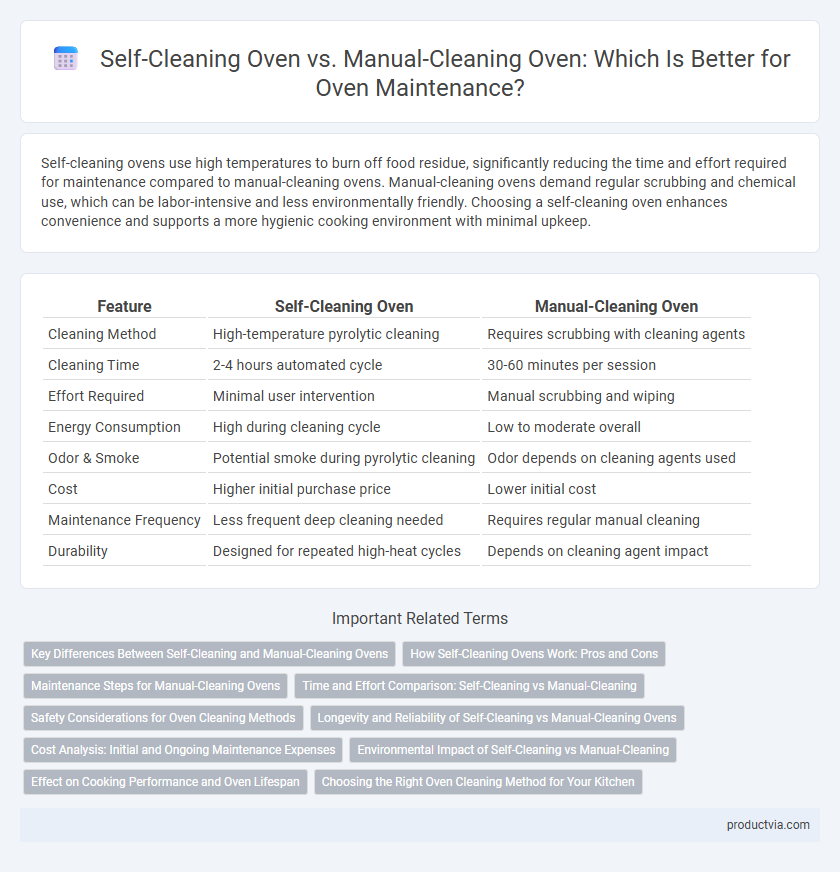Self-cleaning ovens use high temperatures to burn off food residue, significantly reducing the time and effort required for maintenance compared to manual-cleaning ovens. Manual-cleaning ovens demand regular scrubbing and chemical use, which can be labor-intensive and less environmentally friendly. Choosing a self-cleaning oven enhances convenience and supports a more hygienic cooking environment with minimal upkeep.
Table of Comparison
| Feature | Self-Cleaning Oven | Manual-Cleaning Oven |
|---|---|---|
| Cleaning Method | High-temperature pyrolytic cleaning | Requires scrubbing with cleaning agents |
| Cleaning Time | 2-4 hours automated cycle | 30-60 minutes per session |
| Effort Required | Minimal user intervention | Manual scrubbing and wiping |
| Energy Consumption | High during cleaning cycle | Low to moderate overall |
| Odor & Smoke | Potential smoke during pyrolytic cleaning | Odor depends on cleaning agents used |
| Cost | Higher initial purchase price | Lower initial cost |
| Maintenance Frequency | Less frequent deep cleaning needed | Requires regular manual cleaning |
| Durability | Designed for repeated high-heat cycles | Depends on cleaning agent impact |
Key Differences Between Self-Cleaning and Manual-Cleaning Ovens
Self-cleaning ovens utilize high temperatures, around 900degF, to incinerate food residues into ash, significantly reducing the need for scrubbing and chemical cleaners. Manual-cleaning ovens require regular application of abrasive cleansers and physical scrubbing to remove baked-on grease and spills, which can be time-consuming and less efficient. The self-cleaning function offers convenience and safety by containing odors and smoke within a sealed cavity, whereas manual cleaning demands more hands-on effort and exposure to cleaning agents.
How Self-Cleaning Ovens Work: Pros and Cons
Self-cleaning ovens use high temperatures, typically around 900degF (482degC), to incinerate food residue into ash, making maintenance easier by requiring only a simple wipe-down afterward. Pros include reduced cleaning effort, time savings, and minimal use of harsh chemicals, while cons involve longer cleaning cycles, high energy consumption, and occasional unpleasant odors. Manual-cleaning ovens demand regular scrubbing with chemical cleaners or abrasives, which can be labor-intensive and time-consuming but offer greater control over cleaning frequency and intensity.
Maintenance Steps for Manual-Cleaning Ovens
Manual-cleaning ovens require regular removal of racks followed by application of oven cleaner paste or spray, left to sit for a specific duration before scrubbing with a non-abrasive sponge or brush. Users should pay special attention to corners and oven door glass to prevent grime buildup, finishing with a thorough wipe-down using a damp cloth to remove cleaner residues. Frequent maintenance helps avoid thick carbon deposits and ensures the oven's heating elements function efficiently over time.
Time and Effort Comparison: Self-Cleaning vs Manual-Cleaning
Self-cleaning ovens significantly reduce maintenance time by using high temperatures to burn off residue, requiring minimal user effort beyond removing racks. Manual-cleaning ovens demand extensive scrubbing with chemical cleaners, often taking hours to achieve thorough cleanliness. This stark contrast in time and effort makes self-cleaning models a preferred choice for those seeking convenience and efficiency in oven upkeep.
Safety Considerations for Oven Cleaning Methods
Self-cleaning ovens use high temperatures to incinerate food residues, reducing the need for harsh chemicals and minimizing exposure to toxic fumes, enhancing safety during maintenance. Manual-cleaning ovens require chemical cleaners and scrubbing, which can introduce risks of skin irritation, respiratory issues, and accidental ingestion of harmful substances. Choosing a self-cleaning oven can significantly lower the safety hazards associated with oven maintenance compared to manual-cleaning methods.
Longevity and Reliability of Self-Cleaning vs Manual-Cleaning Ovens
Self-cleaning ovens utilize high temperatures to burn off food residue, reducing the need for harsh chemicals and frequent scrubbing, which enhances the appliance's longevity and maintains consistent heating performance. Manual-cleaning ovens require regular physical effort and cleaning agents that can potentially damage internal components over time, leading to decreased reliability and shorter lifespan. Consumers prioritizing durability and low maintenance often prefer self-cleaning models for their efficient residue removal and consistent operational durability.
Cost Analysis: Initial and Ongoing Maintenance Expenses
Self-cleaning ovens feature higher initial costs due to advanced pyrolytic or steam technologies that reduce the need for chemical cleaners and manual scrubbing. Manual-cleaning ovens generally have lower upfront expenses but incur ongoing costs related to purchasing cleaning agents, brushes, and additional labor time. Over time, self-cleaning ovens often offer lower total maintenance expenses by minimizing manual effort and consumable products.
Environmental Impact of Self-Cleaning vs Manual-Cleaning
Self-cleaning ovens use high temperatures to reduce residue to ash, minimizing the need for chemical cleaners and water, resulting in a lower environmental footprint compared to manual-cleaning ovens. Manual-cleaning ovens require chemical detergents and significant water usage, contributing to greater environmental pollution and resource depletion. Choosing a self-cleaning oven can reduce harmful chemical discharge and water consumption, supporting more sustainable kitchen maintenance practices.
Effect on Cooking Performance and Oven Lifespan
Self-cleaning ovens use high heat to burn off residues, reducing the need for harsh chemicals and preserving oven components, which helps maintain consistent cooking performance and extends oven lifespan. Manual-cleaning ovens require regular scrubbing that can inadvertently damage interior surfaces or heating elements, potentially affecting heat distribution and shortening the appliance's durability. Choosing self-cleaning technology enhances long-term efficiency and reliability by minimizing maintenance-related wear and tear on the oven's structural integrity.
Choosing the Right Oven Cleaning Method for Your Kitchen
Self-cleaning ovens use high temperatures to burn off food residues, reducing manual labor and chemical use, making them ideal for busy kitchens. Manual-cleaning ovens require regular scrubbing with specialized cleaners, offering greater control over cleaning but demanding more time and effort. Selecting between these methods depends on your kitchen's usage frequency, maintenance preferences, and sensitivity to cleaning agents.
Self-cleaning oven vs Manual-cleaning oven for maintenance Infographic

 productvia.com
productvia.com